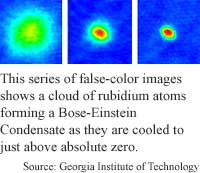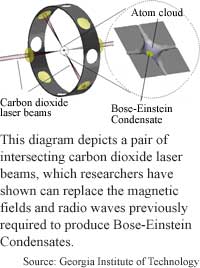
Atom
lasers made easy
By
Eric Smalley,
Technology Research NewsTight control of photons in the form of laser beams is a key ingredient in technologies ranging from the Internet and long-distance telephone lines to CD and DVD players. Tightly controlling atoms in similar ways could also have far-reaching impact.
For several years researchers have been able to make groups of atoms behave like one atomic entity by chilling certain gases to just above absolute zero, and they have been able to produce beams of atoms by shining lasers at these Bose-Einstein Condensates.
But the process requires a complicated combination of laser beams, magnetic fields and radio waves, and the cumbersome laboratory equipment involved makes it difficult to study coherent matter, let alone make useful devices out of it.
A team of researchers at the Georgia Institute of Technology, however, has sidestepped the problem by finding a way to make condensed gas using only lasers.
Atom lasers could be used to deposit material atom by atom on a surface to, for instance, produce extremely fine lines on a computer chip. They could also make extremely sensitive measuring devices because atom waves, like light waves, can interfere with each other and the interference patterns are affected by tiny changes in forces like acceleration and gravity. Condensed atoms could also open the way for quantum mechanically linking thousands of atoms, which could yield extraordinarily powerful quantum computers.
"Researchers have been trying to achieve atomic Bose-Einstein Condensates using all-optical techniques for about 15 years," said Michael Chapman, an assistant professor of physics at Georgia Tech. "What we showed is that not only is it possible, it's downright easy. Better yet, the technique is faster than the magnetic trapping techniques," he said.
The researchers trapped 30 million rubidium atoms in three intersecting low-power laser beams, then transferred the atoms to a trap made of two intersecting high-power laser beams. The transfer left 2 million atoms in the second laser trap. The researchers allowed many of those atoms to evaporate out of the trap, leaving 660,000 much colder atoms, then decreased the power of the lasers, which caused a second round of evaporative cooling.
The researchers were able to make this last step happen in about 2 1/2 seconds, which was fast enough for the remaining 3,500 atoms to form a Bose-Einstein Condensate.
"This is a marvelous piece of work. It is significant because it highlights an efficient and robust route to the production of Bose-Einstein condensed atoms, or atom lasers," said Mark Kasevich, an associate professor of applied physics at Yale University.
Previous Bose-Einstein Condensate experiments trapped atoms with large magnets and cooled them by generating a radio frequency electric field, said Michael G. Moore, a physicist at the Harvard-Smithsonian Center for Astrophysics.
The Georgia Tech experiment replaced both with a commercial carbon dioxide laser. "The increase in simplicity is therefore enormous. The decrease in cost is probably quite significant as well," he said. The all-optical techniques for producing Bose-Einstein Condensates is a significant step toward using condensed matter in practical devices, said Moore.
The Georgia Tech researchers plan to experiment with using the laser-produced Bose-Einstein Condensates for quantum computing, said Chapman.
One problem in quantum computing is information transfer. Atoms are useful for storing and manipulating quantum information but are difficult to transport, while photons are hard to store but could be used to transfer quantum information within and between quantum computers. "A particularly intriguing possibility is to combine the condensates with optical cavities, which are two facing mirrors that trap photons, to exchange quantum information between the photons and atomic condensates," Chapman said.
It it is likely to be more than 10 years before Bose-Einstein Condensates are used in practical applications, said Chapman.
Chapman's research colleagues were Murray B. Barrett and Jacob A. Sauer of Georgia Tech. They published the research in the July 2, 2001 issue of the journal Physical Review Letters. The research was funded by the National Security Agency and the Advanced Research and Development Activity, which is a joint NSA-Department of Defense funding organization.
Timeline: >10 years
Funding: Government
TRN Categories: Optical Computing, Optoelectronics and Photonics; Quantum Computing
Story Type: News
Related Elements: Technical paper, "All-Optical Formation of an Atomic Bose-Einstein Condensate," Physical Review Letters, July 2, 2001
Advertisements:
August 15, 2001
Page One
Atom lasers made easy
Molecule makes mini memory
Does heavy volume smooth Net traffic?
Mind game smooths streaming audio
Quantum effect for chipmaking confirmed


News:
Research News Roundup
Research Watch blog
Features:
View from the High Ground Q&A
How It Works
RSS Feeds:
News
Ad links:
Buy an ad link
| Advertisements:
|
 |
Ad links: Clear History
Buy an ad link
|
TRN
Newswire and Headline Feeds for Web sites
|
© Copyright Technology Research News, LLC 2000-2006. All rights reserved.